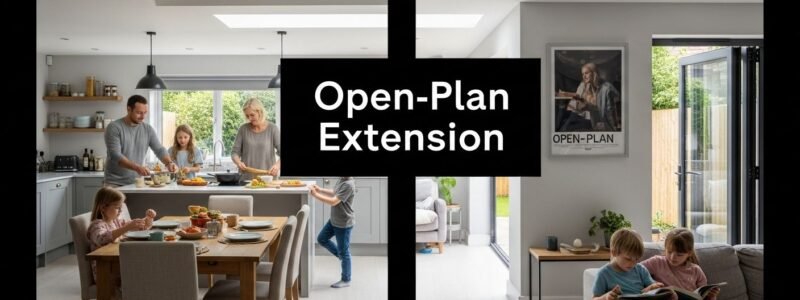Did you know that over one in five UK homeowners has considered a major home extension in the past two years? Modern extensions are evolving quickly, moving toward flexible spaces that combine smart technology, natural elements, and personal style. With living habits changing and property needs growing, staying on top of the latest extension trends can help you create a home that fits your daily life and future plans.
Table of Contents
- Defining Modern Home Extension Trends
- Key Types of Home Extensions in UK
- Influence of Design and Technology Advances
- Legal and Planning Considerations in London
- Cost, Value, and Common Project Challenges
Key Takeaways
| Key Point | Details |
|---|---|
| Modern Extension Trends | Home extensions are evolving towards multifunctional spaces that incorporate technology, sustainability, and biophilic design to enhance wellbeing. |
| Types of Extensions | Options like double-storey, single-storey, and conservatories each have distinct benefits and costs, catering to varying homeowner needs. |
| Design Advancements | Smart home technology and minimalist aesthetics are crucial in creating efficient and visually appealing extensions that adapt to lifestyle changes. |
| Regulatory Considerations | Planning permission may be required for extensive projects, particularly double-storey extensions, necessitating careful adherence to local regulations. |
Defining Modern Home Extension Trends
The landscape of home extensions in the UK is rapidly transforming, moving far beyond traditional building practices into sophisticated, multifunctional living spaces. According to research from Carter Lang Fold, 2025 is set to showcase home extensions that blend technology, sustainability, and personalised design in unprecedented ways.
Modern home extensions are now characterised by hybrid living spaces that serve multiple purposes. Homeowners are creating versatile areas that seamlessly transition between work, leisure, and family activities. These spaces typically feature open-plan layouts with integrated zones that can adapt to changing lifestyle needs. Key design elements include:
- Flexible kitchen-living-dining configurations
- Work-play zones with smart technology integration
- Seamless indoor-outdoor connectivity
- Natural material selections
- Minimalist aesthetic principles
Biophilic design has emerged as a particularly compelling trend, with extensions incorporating natural elements to enhance wellbeing. Floor-to-ceiling glass walls, living plant walls, and strategic natural light placement are transforming how we perceive interior spaces. Explore our guide on modern extension design ideas to understand how these innovative approaches can revolutionise your home’s potential.
Key Types of Home Extensions in UK
Homeowners in the UK have several strategic options when considering home extensions, each offering unique advantages for expanding living spaces. According to research from UK Home Improvement, three primary extension types dominate the current market: double-storey, single-storey, and conservatory extensions.
Double-storey extensions provide the most comprehensive spatial transformation, enabling homeowners to add significant square footage across two floors. These versatile additions can accommodate multiple purposes, from creating additional bedrooms to expanding living areas and enhancing overall home functionality. Common configurations include:
- Bedroom and bathroom additions
- Extended living spaces
- Home office and study areas
- Integrated storage solutions
Single-storey extensions offer remarkable flexibility for homeowners seeking targeted space improvements. These ground-level additions are particularly popular for kitchen expansions, home offices, and open-plan living areas. Discover more about understanding extension types to determine the most suitable approach for your property’s unique requirements.
Conservatories represent a cost-effective extension option, providing abundant natural light and creating a seamless indoor-outdoor living experience.
These glass-enhanced spaces can serve as sunrooms, dining areas, or relaxation zones, offering homeowners a versatile solution for expanding their living environment without extensive structural modifications.
Here’s a comparison of the main types of home extensions in the UK:

| Extension Type | Key Benefits | Typical Uses | Approximate Cost (per m²) |
|---|---|---|---|
| Double-storey | Maximum space Greater value | Extra bedrooms Home office | £1,800-£2,500 |
| Single-storey | Flexible design Quick build | Kitchen extension Open-plan area | £1,800-£2,500 |
| Conservatory | Cost-effective Natural light | Sunroom Dining/relaxation | £1,300-£1,500 |
Influence of Design and Technology Advances
Home extension design in the UK is undergoing a transformative revolution, driven by cutting-edge technological innovations and sophisticated architectural approaches. According to research from Carter Lang Fold, emerging design trends are fundamentally reshaping how homeowners conceptualize and implement living spaces.
Smart home technology has become a cornerstone of modern extension design, enabling unprecedented levels of automation and efficiency. These advanced systems integrate seamlessly into home extensions, offering features like:
- Automated climate control
- Energy management systems
- Intelligent lighting configurations
- Remote monitoring and control
- Voice-activated home management
Biophilic design represents another critical advancement, focusing on creating deeper connections between indoor spaces and natural environments. This approach goes beyond aesthetic considerations, incorporating elements that enhance occupant wellbeing and sustainable living. Explore our guide on modern extension design ideas to understand how these innovative techniques can transform your living space.
Minimalist aesthetics continue to dominate extension design, emphasizing clean lines, functional spaces, and a philosophy of ‘less is more’. By prioritizing simplicity and purposeful design, homeowners can create extensions that are not just visually appealing but also highly adaptable to changing lifestyle needs.
Legal and Planning Considerations in London
Navigating the complex landscape of home extension regulations in London requires careful understanding and strategic planning. According to research from Home Building UK, planning permission requirements can vary significantly depending on multiple critical factors including project size, design complexity, and potential neighborhood impact.
Permitted development rights play a crucial role in determining whether homeowners need formal planning permission. These rights allow certain types of extensions without requiring full approval, but they come with specific limitations. Key considerations include:
- Maximum height restrictions
- Permitted ground coverage percentages
- Proximity to property boundaries
- Impact on neighboring properties
- Materials and design consistency
Double-storey extensions almost universally require comprehensive planning permission. As highlighted by UK Home Improvement, these larger projects demand thorough scrutiny from local planning authorities due to their significant structural implications. Learn more about understanding planning permission requirements to ensure your project complies with all local regulations.
Single-storey extensions offer more flexibility, with many falling under permitted development rights. However, homeowners must still carefully evaluate specific local guidelines, potential neighbor objections, and conservation area restrictions. Proactive consultation with local planning departments can help prevent potential legal complications and ensure a smooth extension process.
Cost, Value, and Common Project Challenges
Home extensions represent a significant investment with complex financial considerations that extend far beyond initial construction costs. According to research from Home Building UK, the true value of an extension involves multiple interconnected factors that can dramatically impact overall project economics.
Project cost variations are substantial, with pricing influenced by several critical elements. Extension types demonstrate different cost structures:
- Single-storey extensions: £1,800 to £2,500 per square metre
- Double-storey extensions: More cost-effective per square metre
- Conservatories: £1,300 to £1,500 per square metre
- Additional expenses include architectural fees, planning permissions
Potential challenges can significantly impact project budgets and timelines. These typically include unexpected structural requirements, planning permission delays, and material cost fluctuations. Learn more about understanding project costs and challenges to help mitigate financial risks.
Ultimately, a well-planned extension can substantially increase property value, often delivering returns significantly higher than the initial investment. Homeowners should approach extensions as strategic long-term investments, carefully balancing immediate costs with potential future property appreciation and enhanced living functionality.
Unlock Your Dream Home with Bespoke Extensions Designed for Modern Living
The journey to creating a spacious, functional, and stylish home extension can feel complex, especially when balancing the latest 2025 trends like smart technology integration and sustainable design. You might be wondering how to navigate planning permissions, control costs, or blend indoor and outdoor spaces with ease. Our expert team at Reltic Extend understands these challenges and works with you every step of the way to turn your home extension vision into reality.
Discover inspiring ideas from our Extension Inspiration & Ideas for Your Home | Reltic Extend collection and gain practical insights through our Design & Build Tips for Home Extensions | Reltic Extend. With over 20 years of experience, transparent pricing, and a 10-year structural warranty, we are dedicated to delivering quality extensions tailored to London’s unique property market. Ready to future-proof your home and add lasting value? Contact us today at Reltic Extend and take the first step towards your perfect home extension.
Frequently Asked Questions
What are the key trends in home extensions for 2025?
Modern home extensions in 2025 will focus on hybrid living spaces, biophilic design, smart technology integration, and sustainable materials. Open-plan layouts and seamless indoor-outdoor connectivity will also play vital roles.
What types of home extensions are most common in the UK?
The three primary types of home extensions are double-storey, single-storey, and conservatories. Each type offers unique benefits, such as increased space, flexibility, or natural light, depending on homeowner needs.
Do I need planning permission for a home extension?
Planning permission requirements depend on the type and scale of the extension. Double-storey extensions usually require full planning permission, while many single-storey extensions may fall under permitted development rights, subject to certain restrictions.
How much can a home extension cost in the UK?
Costs vary depending on the type of extension. Single-storey extensions typically range from £1,800 to £2,500 per square metre, double-storey extensions are more cost-effective per square metre, and conservatories typically cost between £1,300 and £1,500 per square metre.





